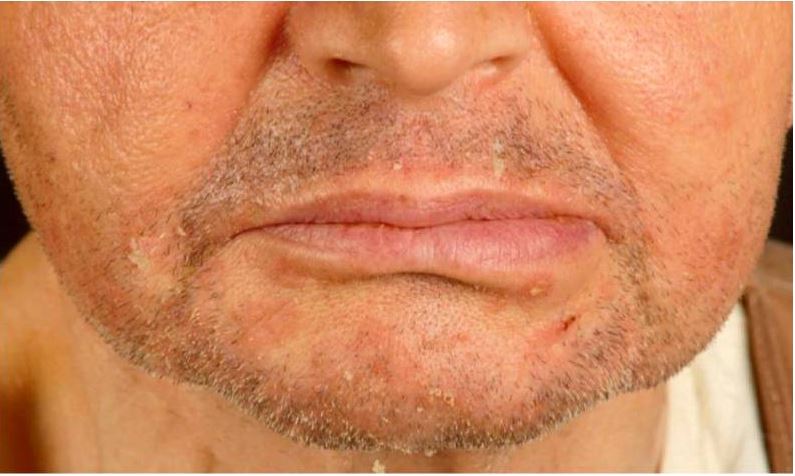Playlist
Show Playlist
Hide Playlist
Seborrheic Dermatitis in Darker Skin: Presentation, Diagnosis, and Management
-
Slides Seborrheic Dermatitis in Darker Skin.pdf
-
Download Lecture Overview
00:01 Welcome to our lecture on seborrheic dermatitis. 00:05 So we classify eczema into exogenous eczemas and endogenous eczemas, as discussed before. So we are now going to talk about seborrheic dermatitis which falls under endogenous eczemas. So how do we define seborrheic dermatitis. 00:22 What is seborrheic dermatitis? It is a chronic, relapsing and usually mild form of dermatitis that mainly affects the sebaceous gland rich regions. So which are the sebaceous gland rich regions. 00:34 It is your scalp, the external ear, the center of the face, the upper part of the trunk, as well as intertriginous areas. 00:42 The worldwide prevalence of seborrheic dermatitis is about 5%, and the prevalence of non-inflammatory variant, which is dandruff, is closer to 50%. So remember, dandruff that you normally see is a non-inflammatory variant of seborrheic dermatitis. 01:03 It's very common among patients of darker skin type. 01:06 It is among the five most common diagnoses observed in black patients. 01:12 It has a biphasic incidence, occurring firstly in infants 2 weeks to 12 months old, and then later on. It can occur in adolescence and adulthood. 01:26 Prevalence had increased among individuals with HIV infection, and in fact seborrheic dermatitis is one of the common manifestations of HIV infection. 01:41 The etiology is not completely understood, but it's linked to abnormal immunologic response to the malassezia furfur, a fungus. 01:50 Now we're going to speak about the clinical manifestations of Cedric dermatitis, focusing on infantile seborrheic dermatitis and adult seborrheic dermatitis. 02:00 And after that, we'll speak briefly about dandruff. 02:04 In light skinned infantile seborrheic dermatitis presents with a classic cradle cap and which is diffuse and greasy, mainly on the crown of the scalp. 02:19 In dark skin, the classic appearance is rare, but it usually presents with erythema, which may be very, very subtle flaking and hyperpigmentation of the affected areas. 02:32 In adults, those who have light skin, they present with well-demarcated erythematous plaques with a greasy-looking yellowish scales. 02:44 However, in dark skin, it typically presents as hypopigmented annular scaly patches without any appreciable or underlying erythema. 02:57 Dandruff is also known as pityriasis capitis. 03:01 Pityriasis refers to scaly and capitis is the scalp. 03:06 It's an inflamed form of seborrheic dermatitis. 03:08 You don't see the erythema and the inflammation, and it may be completely asymptomatic, or sometimes it may be quite itchy. 03:18 So one sees diffuse, brain-like scaly patches within hair-bearing areas of the scalp without underlying erythema. So what are some of the complications of seborrheic dermatitis? Sometimes one m ay see a different clinical presentation that is severe psoriasis, which is thought to be a combination of seborrheic dermatitis and psoriasis. 03:42 Patients can also get secondary infection with virus infection like herpes virus, particularly type one or type two, and this may present as vesicles on a patient with separate dermatitis. In HIV patients, it can be more severe, intractable, chronic, relapsing and secondarily infected with secondary bacteria or herpes simplex virus. And as I mentioned earlier on, sebderm could be a manifestation of HIV infection. 04:20 The clinical diagnosis of seborrheic dermatitis is usually quite obvious, based on the location and the appearance and behavior of the lesions. 04:32 At times, a biopsy may be needed to confirm a case of seborrheic dermatitis. 04:38 If one suspects HIV, particularly if a patient has got extensive seborrheic dermatitis, which can also become erythroderma, meaning more than 90% of the body surface area may be involved. One is it is recommended that we do an HIV screening test. 04:57 The differential diagnosis of seborrheic dermatitis include psoriasis. 05:02 Here, the lesions are sharply demarcated and subtle erythema and scales are more abundant. 05:10 Rosacea, particularly if you're sebderm, is mainly on the face. 05:15 Rosacea can actually mimic seborrheic dermatitis, but in Rosacea , as discussed, you'll see telangiectasia and some papular pustules, and there's minimal scale or totally absent. 05:30 Flexural psoriasis and intertrigo is another differential. 05:34 More so if a patient has got predominant involvement of the flexural areas like the axillae and the groin, but the presence of nasolabial creasing or lesions behind the ear will point towards seborrheic dermatitis. The treatment of seborrheic dermatitis is long-term . 05:56 It is a chronic condition unable to cure it. 06:00 It's primarily managed by controlling and minimizing visible signs of the disease. 06:05 For example erythema and pruritis, while also trying to reduce the associated symptoms. 06:13 It is important that we manage seborrheic dermatitis, as it can affect the quality of life of those patients who are affected. 06:22 The non-inflammatory form, which is dandruff, we use antifungal shampoos like ketoconazole 2% or select products at 1%. 06:34 So the inflammatory form and pruritic forms of seborrheic dermatitis, we use antifungal shampoo, high potency topical corticosteroids for example 5% betamethasone. And we need to make sure that we monitor the patient so that the patient does not develop side effects of corticosteroids. 06:57 More so if the lesions are involving the flexural areas as the occlusive nature of these areas can enhance absorption of topical corticosteroids.
About the Lecture
The lecture Seborrheic Dermatitis in Darker Skin: Presentation, Diagnosis, and Management by Ncoza Dlova is from the course Inflammatory Diseases in Patients with Darker Skin.
Included Quiz Questions
How does infantile seborrheic dermatitis typically present in dark-skinned patients?
- Subtle erythema with flaking and hypopigmentation of affected areas
- Classic "cradle cap" with diffuse greasy scaling on the scalp
- Well-demarcated, erythematous plaques with greasy-looking scales
- Yellowish, oily patches without scaling
- Vesicular eruptions on the scalp
Which presentation would most strongly suggest seborrheic dermatitis rather than flexural psoriasis?
- Presence of scaling in the nasolabial folds and behind the ears
- Involvement limited to axillae and groin
- Sharp demarcation of lesions with thick scaling
- Presence of pustules and telangiectasia
- Symmetric plaques in flexural areas
Which treatment option is most appropriate for managing non-inflammatory dandruff?
- Ketoconazole shampoo
- Topical betamethasone
- Oral fluconazole
- Oral prednisone
- Metronidazole shampoo
Customer reviews
5,0 of 5 stars
| 5 Stars |
|
5 |
| 4 Stars |
|
0 |
| 3 Stars |
|
0 |
| 2 Stars |
|
0 |
| 1 Star |
|
0 |




